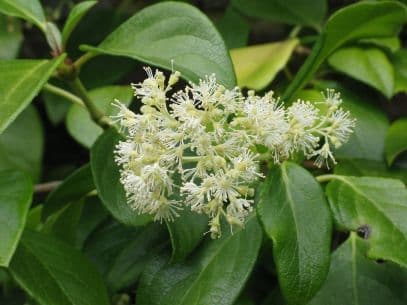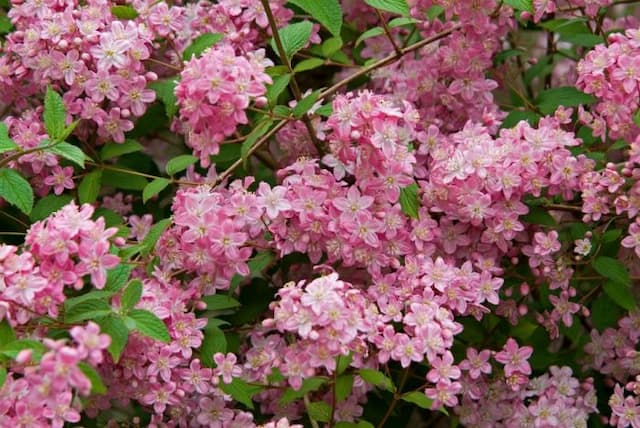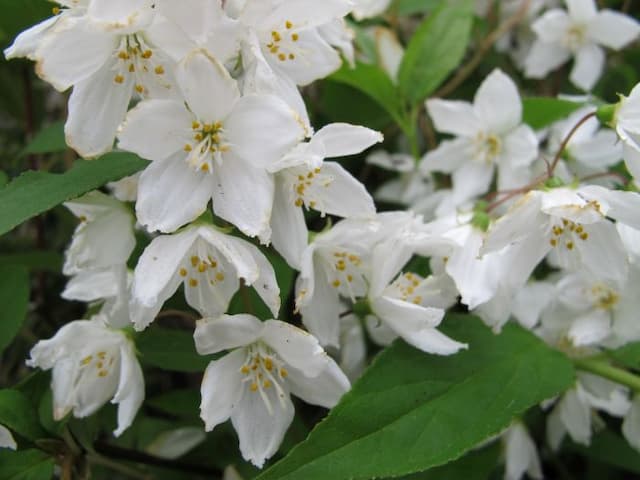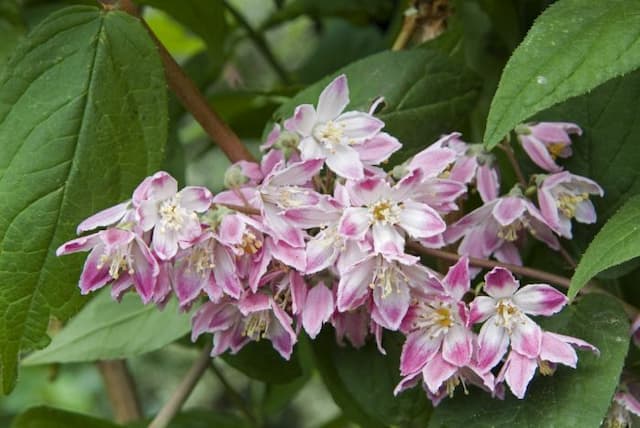Panicle Hydrangea Hydrangea paniculata Polestar = 'Breg14' (PBR)

ABOUT
[Polestar] is a compact, deciduous shrub to just 50cm with broadly oval, coarsely toothed leaves. From early summer to mid-autumn carries rounded, lacy flowerheads combining large, flat, infertile florets with small, blobby, fertile ones. Flowers open white, turning pink then dark pink by autumn
About this plant
 Names
NamesSynonyms
Polestar Hydrangea, Panicle Hydrangea, Peegee Hydrangea
Common names
Hydrangea paniculata 'Polestar', Hydrangea paniculata (Polestar).
 Characteristics
CharacteristicsLife cycle
Perennials
Foliage type
Deciduous
Color of leaves
Green
Flower color
White
Height
4 feet (1.2 meters)
Spread
4 feet (1.2 meters)
Plant type
Shrub
Hardiness zones
3
Native area
Asia
Benefits
 General Benefits
General Benefits- Compact Growth: Hydrangea paniculata 'Polestar' remains relatively small, making it suitable for gardens with limited space.
- Attractive Flowers: It produces large, conical flower heads that start white and gradually turn pink, which are visually striking and add aesthetic value to any garden.
- Long Blooming Period: This hydrangea has an extended flowering period from early summer to late autumn, providing color for several months.
- Hardiness: It is a hardy plant that can withstand cold temperatures, making it appropriate for a variety of climates.
- Low Maintenance: 'Polestar' requires minimal pruning and care once established, making it a good choice for both novice and experienced gardeners.
- Attracts Pollinators: The flowers attract bees and butterflies, which is beneficial for pollination of other plants in the garden.
- Versatile Landscaping: Can be used in a variety of garden settings, including borders, as a focal point, or in mass plantings for dramatic effect.
- Drought Tolerant: Once established, it can tolerate some drought, reducing the need for frequent watering.
- Deer Resistant: Its foliage and flowers are not particularly attractive to deer, reducing the likelihood of damage from wildlife.
 Medical Properties
Medical PropertiesThis plant is not used for medical purposes.
 Air-purifying Qualities
Air-purifying QualitiesThis plant is not specifically known for air purifying qualities.
 Other Uses
Other Uses- Photography Prop: Hydrangea paniculata 'Polestar' can be used as a stunning photography backdrop for portraits or macro photography due to its large, attractive blossoms.
- Craft Projects: The dried blooms of the hydrangea can be used in floral arrangements or craft projects like wreath making for rustic or shabby chic decor.
- Culinary Decoration: Although not for consumption, the flowers can be used to decorate cakes or plates in culinary settings for an ornamental touch.
- Insect Shelter: In a garden, the dense foliage of the hydrangea can provide shelter for beneficial insects like ladybugs and bees.
- Color Changing Experiment: By adjusting soil pH, gardeners can use hydrangea to demonstrate how soil chemistry affects bloom color, an educational experiment for children and adults alike.
- Dye Source: The flowers of the hydrangea can be used to naturally dye fabrics or paper, providing a range of colors from pinks to blues.
- Garden Time Marker: As the hydrangea blooms at a specific time during the summer, it can serve as a natural marker for gardeners to track the growing season.
- Privacy Screen: When planted in groups, hydrangea can provide a picturesque privacy screen during the blooming season due to their size and fullness.
- Creative Containers: The hydrangea can be grown in a variety of containers, giving gardeners with limited space the opportunity to enjoy their beauty on patios or balconies.
- Feng Shui: Some practitioners use the hydrangea in home landscaping and design to enhance the chi and bring a sense of abundance and grace to living spaces.
Interesting Facts
 Feng Shui
Feng ShuiThe Hydrangea is not used in Feng Shui practice.
 Zodiac Sign Compitability
Zodiac Sign CompitabilityThe Hydrangea is not used in astrology practice.
 Plant Symbolism
Plant Symbolism- Heartfelt Emotions: Hydrangeas, which include the Hydrangea paniculata Polestar, are often associated with the expression of deep, heartfelt emotions or gratitude.
- Understanding: The diversity of colors and the complexity of the Hydrangea's blooms are symbolic of understanding and comprehension, much like the multifaceted aspects of the flower's globular shape.
- Frivolity or Boastfulness: In some cultures, hydrangeas represent boastfulness due to the lavish number of flowers and the showiness of their blooms.
- Abundance: As the Hydrangea produces many flowers and grows quite large, it is symbolically linked to abundance and prosperity.
- Femininity: The delicate nature of the Hydrangea's flowers often relates to traditional symbols of grace and femininity.
- Apology or Remorse: Some regard hydrangeas as a symbol of apology or the desire to make amends due to Japanese legend wherein an emperor gifted them to express regret for neglecting someone he cared about.
 Water
WaterThe Panicle Hydrangea should be watered deeply once a week, providing about one to one and a half gallons of water each time, to ensure the soil stays consistently moist but not waterlogged. During particularly hot or dry weather, it may require more frequent watering, possibly twice a week. It is best to water the plant early in the morning at the base, avoiding overhead watering to prevent leaf moisture, which can lead to fungal issues. Adjust watering during rainy periods, as excessive water can cause root rot. Mulching around the base can help retain soil moisture and reduce the need for frequent watering.
 Light
LightPanicle Hydrangea thrives in full sun to partial shade, with a preference for morning sunlight and afternoon shade. Ideal spots are those receiving sunlight for at least 4 to 6 hours a day, particularly in cooler regions. In regions with intense sun, it benefits from protection during the hottest part of the day to prevent scorching of the leaves.
 Temperature
TemperaturePanicle Hydrangea is hardy and can tolerate a wide range of temperatures, enduring minimum winter temperatures down to about -20 degrees Fahrenheit. However, it grows best in a range where summer temperatures do not regularly exceed 90 degrees Fahrenheit. The ideal temperature for robust growth and flowering is between 65 and 75 degrees Fahrenheit.
 Pruning
PruningPruning Panicle Hydrangea in late winter or early spring helps to encourage new growth and improve flowering. Remove any dead or crossing branches and trim back last year's growth to a pair of healthy buds to shape the plant and promote a sturdy structure. Annual pruning keeps the shrub vibrant and is the best time since the shrub blooms on new wood.
 Cleaning
CleaningAs needed
 Soil
SoilThe Panicled Hydrangea prefers fertile, well-draining soil with a high organic matter content. A good soil mix for this plant would be one part garden soil, one part peat moss or compost, and one part perlite or sand. The ideal soil pH for Panicled Hydrangea is slightly acidic to neutral, ranging from pH 5.5 to 7.0.
 Repotting
RepottingPanicled Hydrangea generally does not need frequent repotting and can thrive in the same pot for several years. Repotting is typically required every 3 to 5 years, or when the plant becomes too large for its current container or the soil is exhausted.
 Humidity & Misting
Humidity & MistingPanicled Hydrangea thrives in average to high humidity conditions. The best humidity level for this plant is between 50% and 70%. It can tolerate lower humidity levels, but maintaining an overall moist environment will help the plant flourish.
 Suitable locations
Suitable locationsIndoor
Keep Panicled Hydrangea in bright, indirect light indoors.
Outdoor
Place Panicled Hydrangea in partial sun; mulch and water regularly.
Hardiness zone
3-8 USDA
 Life cycle
Life cycleThe life of Hydrangea paniculata Polestar, commonly known as PeeGee hydrangea, begins with seed germination, which is relatively uncommon in cultivated varieties as they are typically propagated asexually. Following germination, the young plant enters a vegetative stage, producing leaves and stems as it establishes a root system. The next stage is maturation, where the hydrangea develops woody stems and prepares for flowering, with the plant blooming in the summer to early fall, showcasing panicles of white flowers that age to a pinkish hue. After the flowering stage, the plant enters a period of senescence for its above-ground parts in the fall, with the leaves dropping as it goes dormant for the winter. Below ground, the root system remains alive, storing energy for the next growing season. In spring, the cycle repeats as the plant breaks dormancy, producing new growth and progressing back to the flowering stage.
 Propogation
PropogationPropogation time
Summer
The most popular method to propagate Hydrangea paniculata 'Polestar' is through softwood cuttings. Softwood cuttings are taken from new growth that is not yet firm in the late spring or early summer. Carefully cut a 4-6 inch (10-15 centimeters) piece of stem with several leaves, making sure there's at least one node on the cutting, which is where the leaf meets the stem. The bottom leaves are removed and the cut end is often dipped into a rooting hormone powder to encourage root development. The cutting should then be placed in a pot with well-draining soil, kept moist, and placed in indirect sunlight. Roots typically develop in a few weeks, and once they've established, the young hydrangea can be moved to a larger pot or directly into the garden.






![Rose deutzia [Yuki Cherry Blossom]](/_next/image?url=https%3A%2F%2Fplants-admin.emdemapps.com%2Fimages%2Fplants%2F%2Fimages%2F604b6510a383a.png&w=640&q=75)
![Hydrangea [Hot Chocolate]](/_next/image?url=https%3A%2F%2Fplants-admin.emdemapps.com%2Fimages%2Fplants%2F%2Fimages%2F604b5a066e3bd.png&w=640&q=75)
![Hydrangea [Blackberry Pie]](/_next/image?url=https%3A%2F%2Fplants-admin.emdemapps.com%2Fimages%2Fplants%2F%2Fimages%2F604b56e2abc1d.png&w=640&q=75)
